Thou shall not kneel before the power of pen and paper!
Electronic signature technology has liberated businesses from the burdensome task of signing documents using ink and paper.
As Esther Dyson rightly said, “Change means that what was before wasn’t perfect.”
Electronic signatures added convenience and capabilities to process the documentation work from anywhere and lifted the online economy.
From employment agreements and filing loan applications to closing deals with customers – all it takes is a tap/click/touch, and signatures are done.
But wait!
Are you sure your document qualifies for eSignatures?
Are you aware of the procedural demands to be followed while electronically signing the documents?
The application of electronic signatures differs from country to country. Therefore, you must be aware of the local laws before executing any electronic transaction.
This blog takes a deep dive into the two laws that govern electronic signatures in the United States – ESIGN Act and UETA.
Evolution of electronic signatures & adoption of eSignature laws in the United States
Evolution of electronic signatures
From wax seals, copperplate scripts, pictographic scripts to electronic forms – signature methods have gone through a radical change.
Did you know morse code was the first medium to send electrical messages via a telegraph?
In 1869, the New Hampshire Supreme Court in the United States accepted the enforceability of an e-signature sent via telegraph.
Fast forward 110 years – Fax machines set the trend in the 1980s to deliver urgent and time-bound documents. Signatures transmitted via fax machines were considered legally valid.
A decade later, in the late 1990s, when the electronic commerce industry started booming, a surge in online transactions pushed the need to legitimize electronic signatures.
Commencement of electronic signature laws
In 1995, Utah’s Digital Signature Act became the first state law in the United States to accept the enforceability of electronic signatures.
Following Utah’s footsteps, California’s lawmakers passed digital signature legislation known as Assembly Bill 1577 in 1995 and Illinois implemented the Electronic Commerce Security Act in 1998.
But seeing the variations in emerging state laws, the National Conference of Commissioners on Uniform State Laws proposed to lay down standard guidelines to bring uniformity in the state laws.
The arrival of the UETA and ESIGN Act
1. Uniform Electronic Transactions Act (UETA)
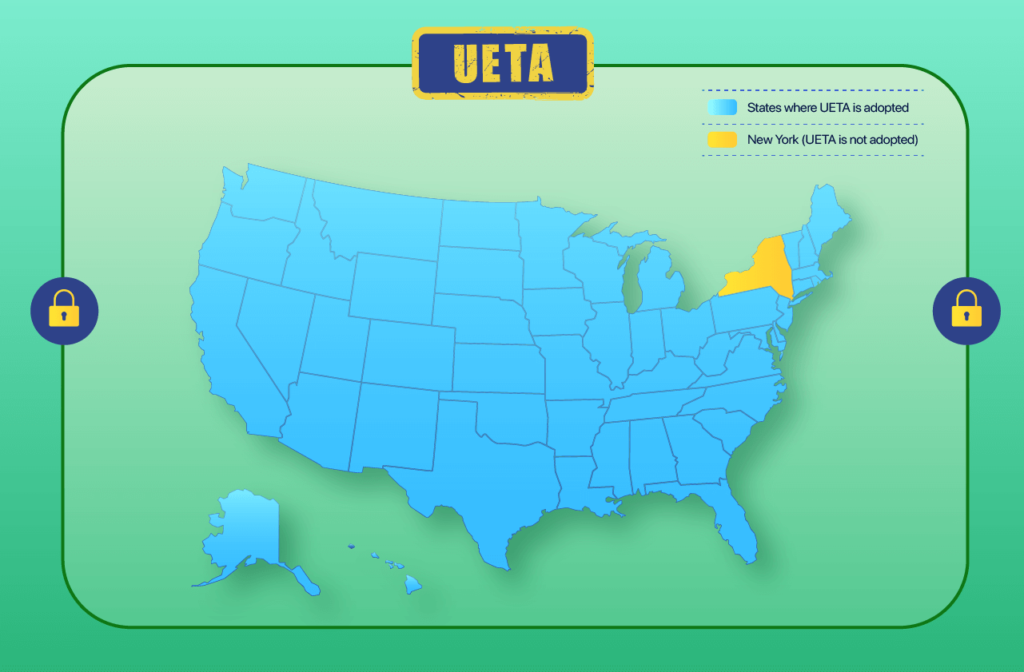
The Uniform Electronic Transactions Act (UETA), a state law, was established in 1999 to define the legal framework to facilitate both government and commercial transactions.
Which states have adopted UETA and which haven’t?
49 states have adopted the regulation alongside the US Virgin Islands, the District of Columbia, and Puerto Rico. The only state that hasn’t embraced the Uniform Electronic Transactions Act is New York.
Is there any law that ensures the enforceability of eSignatures in New York state?
Yes, all individuals and businesses from public or private sectors must comply with the New York Electronic Signatures and Records Act (ESRA) to apply or accept electronic records and signatures within New York jurisdiction.
As stated in the Act – “The purpose of the Electronic Signatures and Records Act (ESRA) is to facilitate eCommerce and e-Government in New York State by giving electronic signatures (e-signatures) and electronic records (e-records) the same force and effect as signatures and records produced by non-electronic means.”
The ESRA grants electronic signatures and electronic records the same legal weightage as their paper cousins, subject to certain exceptions specified in ESRA.
2. Electronic Signatures in Global and National Commerce Act (ESIGN)
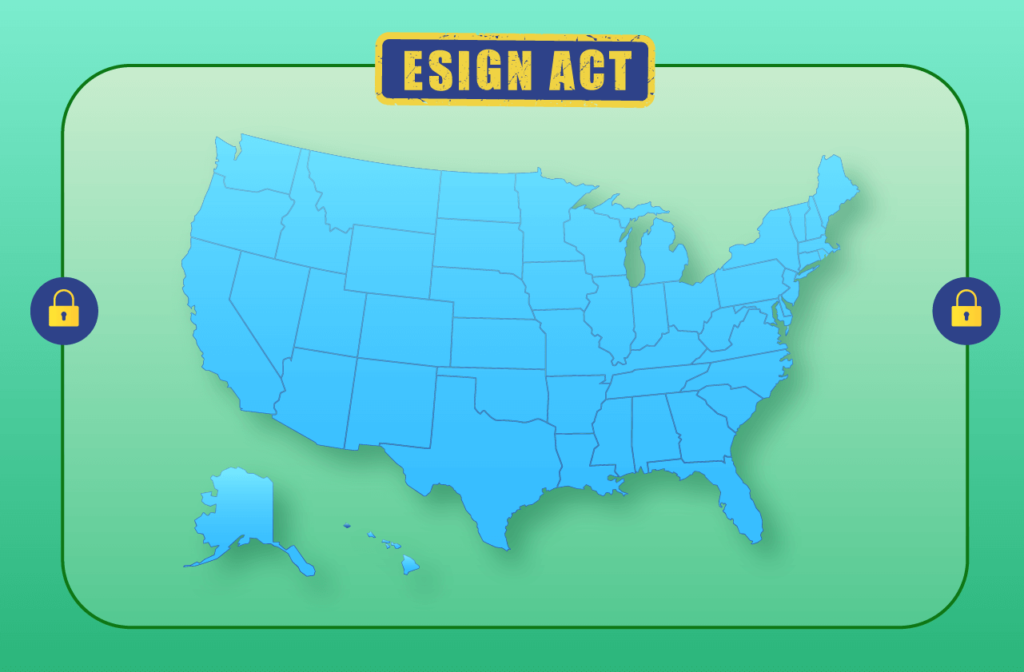
On June 30, 2000, the US government passed the Electronic Signatures in Global and National Commerce Act (ESIGN) and made it a federal law.
The ESIGN Act gives e-signatures the same legal effect as handwritten signatures in all the states of the US or the territories where the federal law applies.
UETA and ESIGN Act – What makes them similar?
Following are the commonalities shared by both these regulations. Both UETA and ESIGN Act:
- Give electronic signatures the same weightage as wet signatures. Together, they have created a solid foundation to encourage the lawful use of electronic documents and records.
- Provide the same definition of electronic signatures
- State that no electronic record or signature may be denied legal effect solely because of its electronic form
- Mandate to follow four rules to prove the legal validity of eSignatures – clear intent, consent to do business electronically, association of signature with the record, and retention of records
- Do not put a greater emphasis on any specific technology to obtain electronic signatures
- Share a common motive – ease commercial transaction
UETA and ESIGN Act – What makes them distinct?
Here are some key pointers that differentiate both the acts:
- The ESIGN Act is a federal law that spans across the US and influences all 50 states, whereas UETA is adopted on a state-by-state basis.
- The UETA act holds greater priority in case of disputes.
- The ESIGN Act governs the guidelines for e-signatures, contracts, or other records within foreign and interstate commerce. In contrast, UETA controls only electronic signatures and records associated with business, commercial, and governmental affairs.
What constitutes an electronic signature as per the UETA and ESIGN Act?
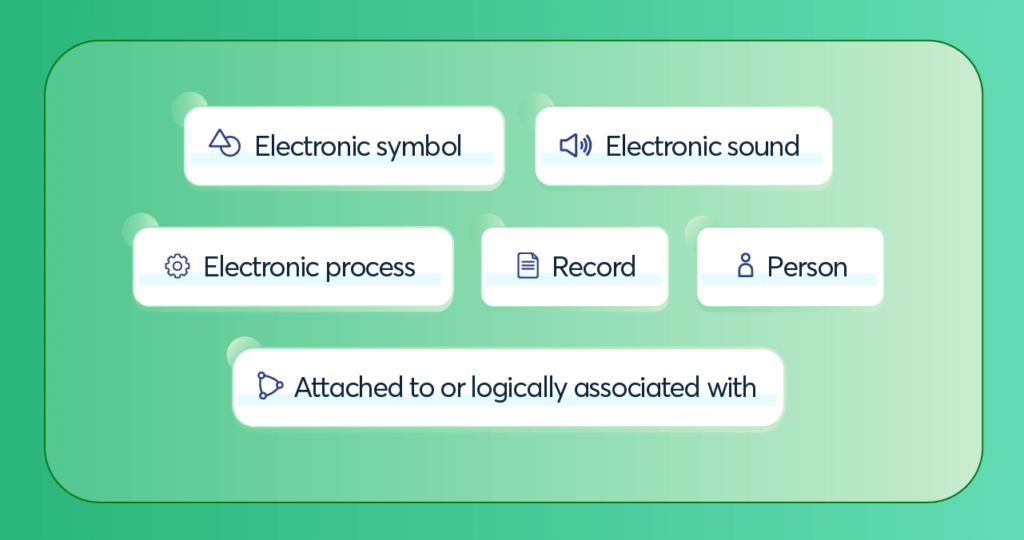
According to UETA and ESIGN Act, an electronic signature is defined as “electronic sound, symbol, or process attached to or logically associated with a record and executed or adopted by a person with the intent to sign the record.”
Let’s decipher this definition bit-by-bit and understand what each term means:
Electronic symbol
Have you ever:
Checked an “I agree” box while installing a software?
Or
Clicked on the “Place order” button during online shopping?
Or
Signed an invoice with a digital pen pad device at a point of sale?
Checkboxing “I agree” or tapping on “Place order” denotes the ‘symbol’ part of eSignature.
In fact, the word ‘symbol’ means any legally valid form of electronic signatures, which includes clicking on the yellow signature box, confirmation via emails, adding a signature image, sending a scanned PDF of a handwritten signature, and typing in a ‘conformed’ signature.
Electronic sound
At the core, adding your electronic signatures to a contract or any other document dictates that you agree to all the provided terms and conditions. It also means that now the laws bind the business transaction between you and the other party.
The affirmation sent by businesses and users through a verbal (voice or video) note is also deemed as valid and equivalent form of electronic signature.
However, voice signatures are only considered valid when they comply with certain terms, which include:
- All parties involved in the transaction accepting “I Agree” statements
- The association of voice signature
- Encryption of files to prevent the disintegration of voice note or forgery
| Quick Bite: The verbal signatures have played a key role in the roll-out of the Affordable Care Act (ACA) by accepting telephonic applications and signatures in Medicaid and Children’s Health Insurance Plan (CHIP) programs. |
Electronic process
The electronic process detangles the ‘how’ aspect of electronic signatures. Think of it as a witness making note of every step taken to affix and record electronic signatures.
When a plaintiff demands legal action claiming one of the below scenarios, the court’s judgment heavily relies on attribution and process.
“I didn’t sign this contract.”
Or
“These aren’t my signatures.”
Or
“My signatures are forged.”
In order to be certified as valid, the system used to sign documents must record the process of signature creation and each step taken by the signer to execute the transaction.
| Quick Bite: Here are examples of two interesting cases that weave the validity of electronic signatures with its process: 1. Zakuski v. General American: In this case, the recorded electronic process confirming a switch in insurance beneficiary was justified as adequate for showing intent. 2. Schrock v. Nomac Drilling, LLC: In this case, the court overruled the former employee’s challenge to the legitimacy of the e-signature as his employer presented evidence with an audit trail. It confirmed that the document was electronically signed through the employee’s social security number at a specific place and a particular time when the former employee was present at the same location. |
Attached to or logically associated with
Once affixed, a wet signature becomes an inseparable part of the physical paper and stays there forever. Similarly, the linking of an electronic record to an electronic signature is required during transmission and storage.
Record
As stated in the law, the term “record” means information
- Inscribed on a tangible medium
- Stored in an electronic or another medium
- Retrievable in perceivable form
Person
As stated in the law, the term ‘‘person’’ means an individual, corporation, business trust, estate, trust, partnership, limited liability company, association, joint venture, governmental agency, public corporation, or any other legal or commercial entity.
UETA and ESIGN Act requirements that make an electronic signature legally binding
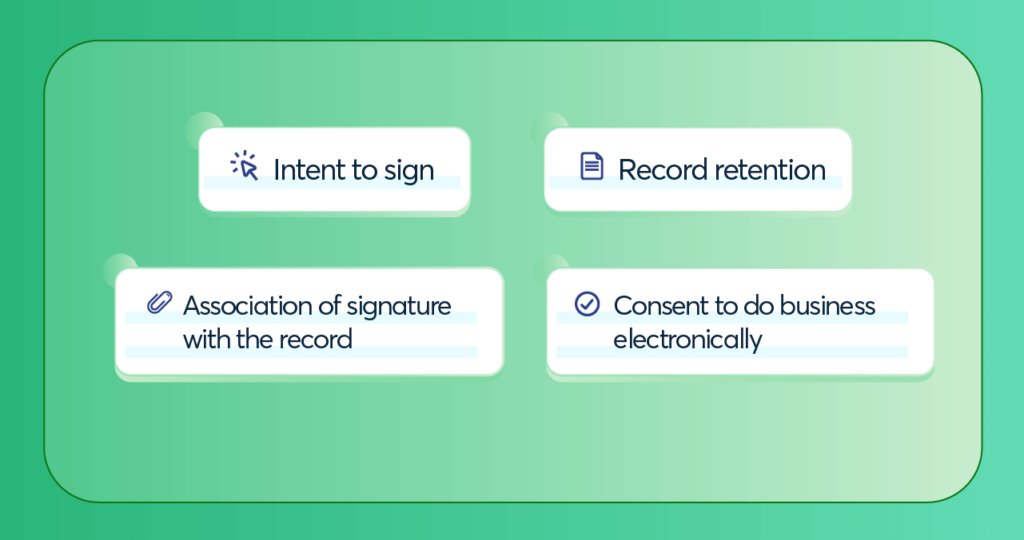
There are four crucial and also standard requirements in UETA and ESIGN Act that ensure your document is legally compliant in the United States:
Intent to sign
“Are you certain about signing this document?”
Or
“Do you want to opt out?”
Like their paper-based equivalents, electronic signatures are only valid when a signer displays a willful intent to sign.
Consent to do business electronically
The parties to the transaction must either display or imply their consent before transmitting information electronically.
| UETA Section 5(b) states – This [Act] applies only to transactions between parties, each of which has agreed to conduct transactions by electronic means. Whether the parties agree to conduct a transaction by electronic means is determined from the context and surrounding circumstances, including the parties’ conduct. ESIGN Act Section 101(c) requires institutions to obtain a “consumer disclosure” that confirms the signatory’s consent to use an electronic method. According to this section, the signers must be informed of their rights and options – – The option to provide or make the record available in a paper format or non-electronic form – The right to withdraw the consent, any associated conditions, consequences, and fees in the event of such withdrawal – The right to know if the consent pertains to a particular agreement or to a wider range of records that may be provided in the course of the parties’ relationship. – The procedures a consumer must use to withdraw a consent – How can the consumer request a paper copy of a record and learn if there is any fee associated to obtain a paper copy? |
Association of signature with the record
Remember the “attached to or logically associated with” part in the e-signature definition? It means that the eSignatures must be connected to the signed document.
An eSignature qualifies this requirement when:
- The system used to process the transaction also records the process explaining how the signature was obtained, or
- Generates a textual or graphic statement to prove that the transaction was processed via electronic means
The electronic signature vendors accomplish this by providing electronic evidence with a complete audit trail of each transaction – signer’s details, date and time stamp of each action taken, geolocation capture, IP address, and authentication process.
| UETA Section 9 sheds light on attribution and effect of electronic record and e-signature. (a) An electronic record or electronic signature is attributable to a person if it was the act of the person. The act of the person may be shown in any manner, including a showing of the efficacy of any security procedure applied to determine the person to which the electronic record or electronic signature was attributable. (b) The effect of an electronic record or electronic signature attributed to a person under subsection (a) is determined from the context and surrounding circumstances at the time of its creation, execution, or adoption, including the parties’ agreement, if any, and otherwise as provided by law. ESIGN Act Section 101(c)(1)(C) states – The consumer also “consent electronically, in a manner that reasonably demonstrates that the consumer can access information in the electronic form that will be used to provide the information that is the subject of the consent.” |
Record retention
US eSignature laws require that all parties involved in the transaction satisfy the record retention requirement as long as their record accurately reflects the original information and can be reproduced for future reference.
| UETA Section 12(a) states that (a) If a law requires that a record be retained, the requirement is satisfied by retaining an electronic record of the information in the record which: 1. Accurately reflects the information set forth in the record after it was first generated in its final form as an electronic record or otherwise; and 2. Remains accessible for later reference ESIGN Act section 101(d) provides that if a law requires that a business retain a record of a transaction, the business satisfies the requirement by retaining an electronic record, as long as the record – Accurately reflects the information of the original record – Remains accessible to people who are entitled to access it – Is in a form that is capable of being accurately reproduced for later reference, whether by transmission, printing, or otherwise |
Are there any exceptions to the UETA and ESIGN Act?
Here is a list of documents that don’t come under the scope of the ESIGN Act and UETA and may not apply to specific situations.
ESIGN Act exceptions
- Wills, codicils, and testamentary trusts
- Adoption paperwork
- Divorce agreements
- Certain transactions governed by the Uniform Commercial Code, as in effect in any state, except for sections 1–107 and 1–206 and Articles 2 and 2A.
- Court orders or notices, or official court documents
- Termination of utility services
- Notices for eviction, default, repossession, or foreclosure
- Cancellation of insurance benefits
- Product recalls or notice of material failures that risk health or safety
- Contracts or documents governed by the Uniform Commercial Code (UCC)
- Documentation concerning the transportation or handling of hazardous or toxic materials
UETA exceptions
- Wills, trusts, or codicils
- Transactions governed by the Uniform Commercial Code, other than sections 1–107 and 1–206 and Articles 2 and 2A.
- Transactions related to the Uniform Computer Information Transactions Act
- Other laws, if any, identified by state
| DISCLAIMER: This article intends to provide you information w.r.t the ESIGN Act and UETA. While we have taken all steps to ensure that all the information provided here is right, please note that this article is not a substitute for legal advice. Electronic signature laws can change, and we don’t guarantee that the details in this article stand correct all the time. If you need to know about the legality and implementation of electronic signatures in your location, please consult legal counsel. |
Revv | Your eSignature partner in executing ESIGN Act and UETA compliant agreements
Revv is a modern eSignature and document automation platform that complies with both the ESIGN Act and UETA and makes all electronically signed documents legally binding.
Revv meets all the four key requirements that make an electronic signature valid. Here’s how –
Intent to sign – Revv provides a ‘Decline to sign’ option to the signing parties. It gives them the power to decide whether they want to sign the document electronically or not, thus capturing the intent.
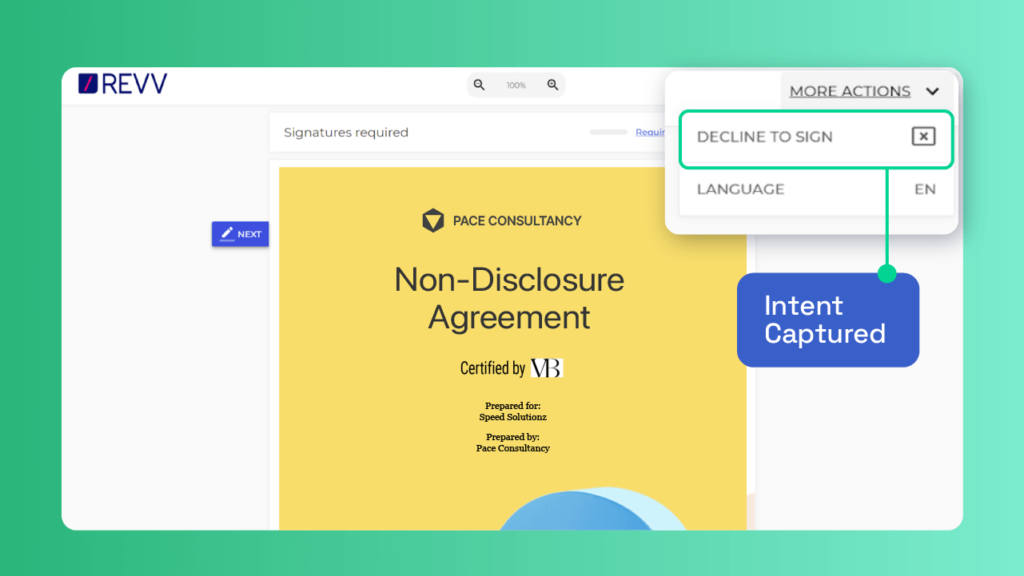
Consent to do business electronically – Revv captures the consent of the signing parties by asking them to click on the ‘Confirm’ button before submitting the document.
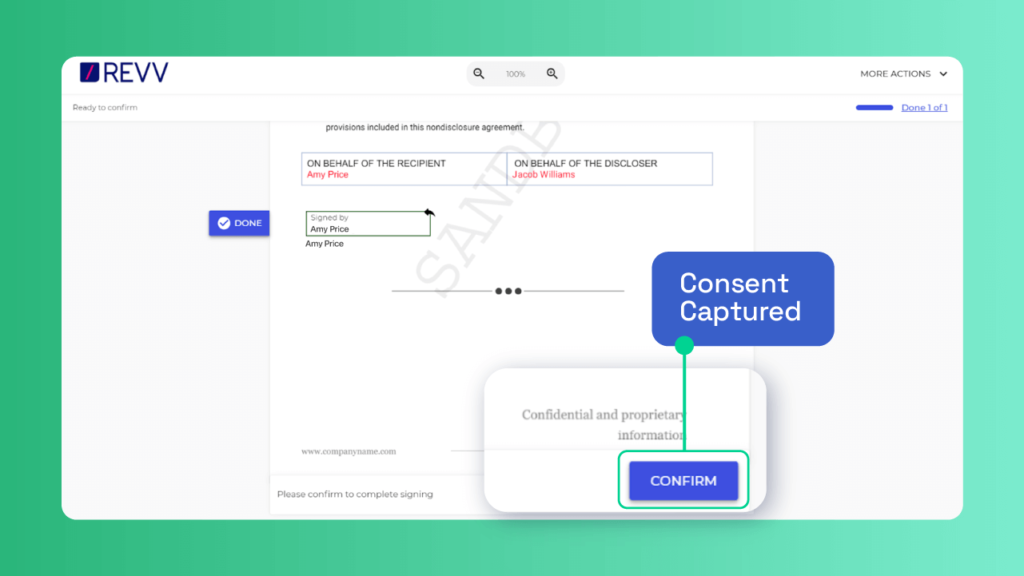
Association of signature with the record – Once a signer completes the signing process, the added eSignatures with date and time stamp become a permanent part of the document.
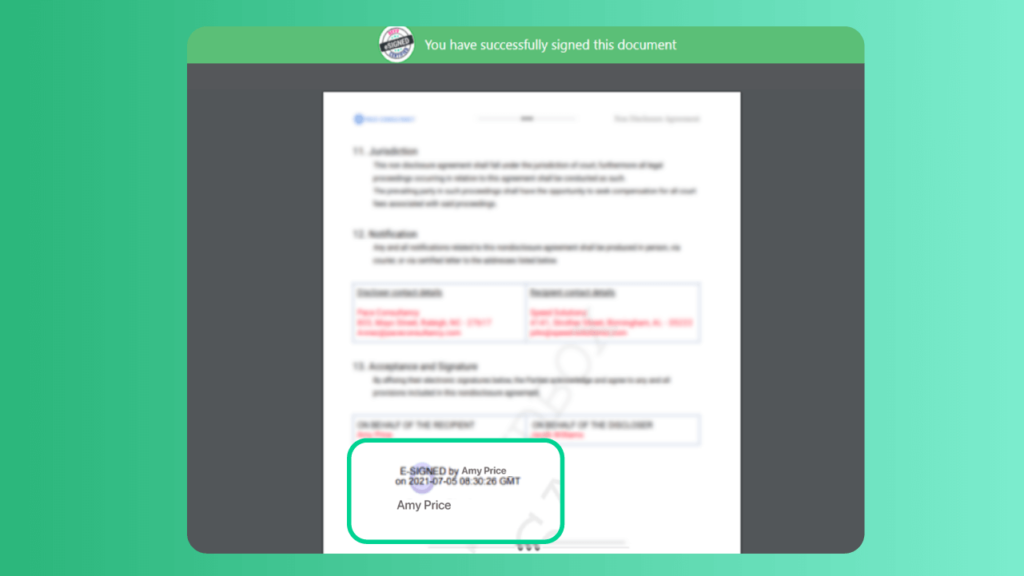
Revv provides an evidence summary with an all-inclusive audit trail. It captures all the details surrounding an electronic transaction like –
- Signer’s information (name, email, and unique id)
- Date and time stamp of each action taken by the signer
- IP address, and
- Other details that act as proof of transaction
Record retention – Once signed, Revv generates a copy of signed records and offers users to download a copy before closing the browser window.
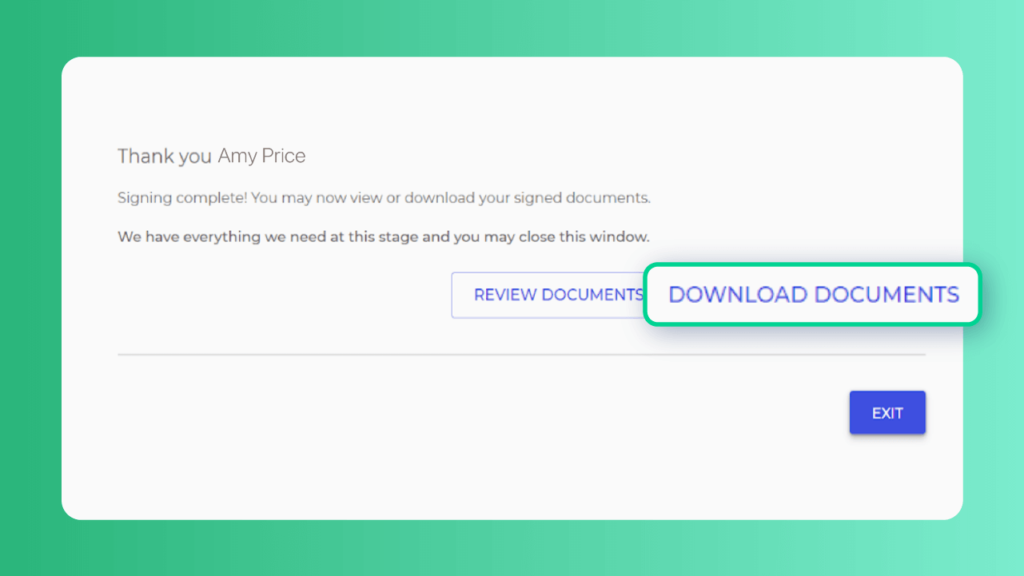
Revv also sends a signed copy of the document to the signing parties via email.
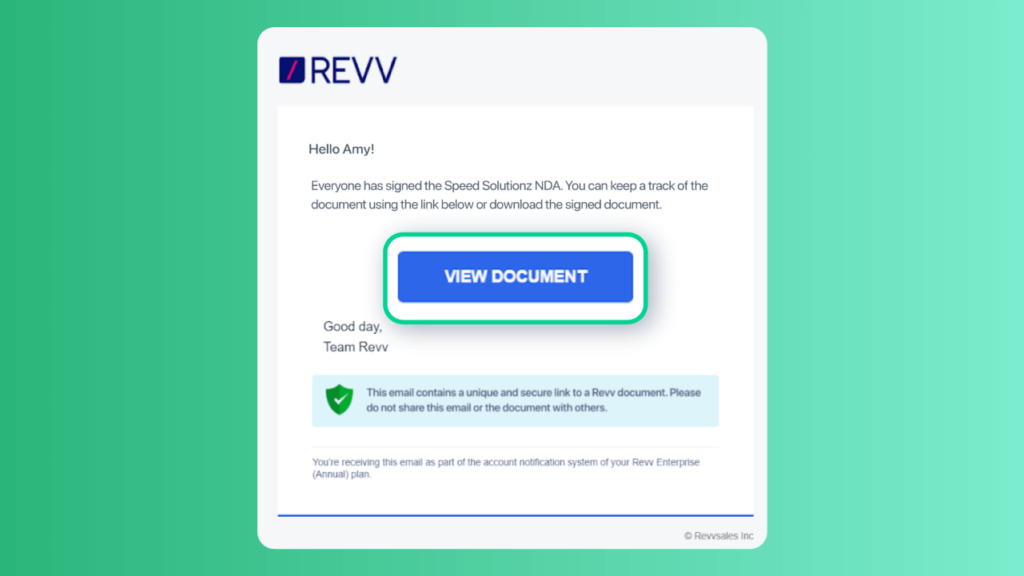
All the signed documents are also stored in Revv’s system and are accessible to users once they sign in to the system.
Revv uses AWS SSE-S3 (Amazon Web Services Server-Side Encryption) to provide a secure and lifetime cloud storage of all signed records.
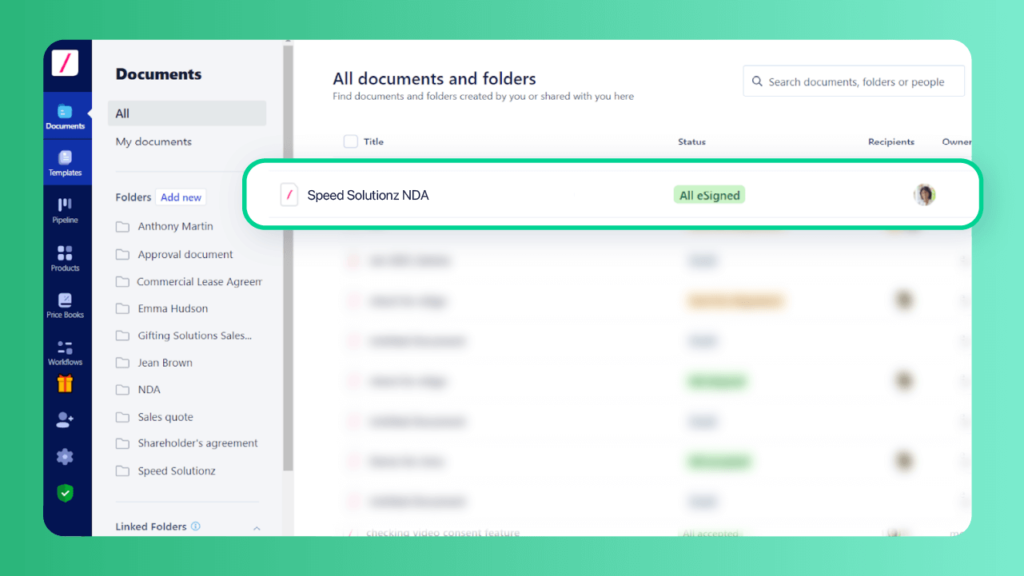
This is just the beginning!
Revv offers a pool of advanced features to empower users with intelligent and seamless electronic signature workflows and help them to speed up the signing process.
- Bank-grade electronic signature technology to protect information at every step
- Robust security with multiple layers of encryption and AWS global cloud certification – CSA, SOC 1, SOC 2, and ISO 2700.
- 2FA (two-factor authentication) to confirm the identity of signers
- Dynamic form fields to accelerate the signing process
- Ease of uploading and editing PDF or DOCX files and sending them for e-signatures
- Collect crucial information from the recipients in text or image form using the ‘Fill and sign’ feature
- 1000+ aesthetically-pleasing, formatted, structured, and legally vetted business document templates help to create business documents super fast
- Rich editor with customization features
- Create and send multiple documents at once using the ‘Bulk Send’ feature
- Three signature types to choose from – click-to-sign, draw a signature, or click-to-initial
- Set up eSignature workflows through Native API and Zapier integration and save big on time, money, and resources
- Get an ‘inside view’ of what is happening in the signing process. Has the document been viewed? Is it signed or not?
- Real-time notifications to take action on the document and to keep a tab on the progress of the eSignature process
- Easy sharing of documents via email, shareable links, fillable web forms, or API integrations
- Forever cloud storage to keep all the records organized in one central place
- Device compatibility to get documents signed from any device
- Real-time collaboration and communication with internal teams or customers within the document through tags, notes, and attachments
- An intuitive interface that is easy to use and simple to understand
| Start your eSignature journey with Revv! Sign up for Free No Risk, No Credit Card Required |
Conclusion
Both ESIGN Act and UETA have created a robust legal landscape to –
- Resolve the security and court-admissibility concerns related to the usage of electronic contracts and documents, and
- Confidently transition from traditional paper documents.
Therefore, a compliant eSignature service provider plays a crucial role in abiding by the guidelines of these regulations.
Revv’s compliance with local and global eSignature laws and its modern features makes it a one-stop partner for eSignature and document automation needs.
Professionals, businesses, and enterprises of varied sizes use Revv to run their business anywhere, anytime, and from any device.



